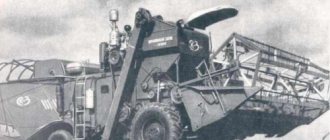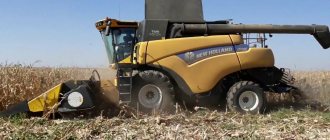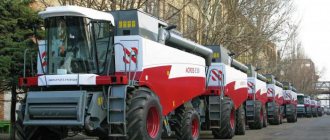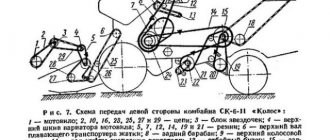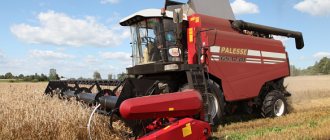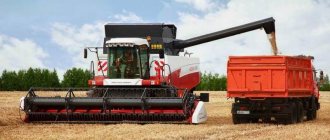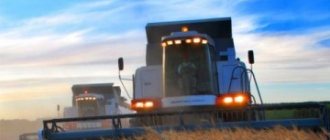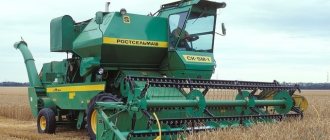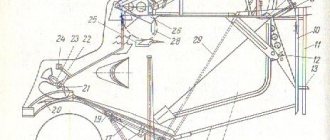The SK-3 self-propelled combine was produced in the middle of the last century, and for a very short time - only a few years. However, during this time he managed to surprise the world, and also received the Grand Prix award at the World Exhibition in Brussels. This happened in 1958, and now the combine has become a rarity - you can even see it in the Estonian museum.
Combine harvester SK-3: device, technical characteristics, photo
The SK-3 self-propelled combine was produced in the middle of the last century, and for a very short time - only a few years. However, during this time he managed to surprise the world, and also received the Grand Prix award at the World Exhibition in Brussels. This happened in 1958, and now the combine has become a rarity - you can even see it in the Estonian museum.
Combine harvester SK-3
The development of the model took place in Taganrog, at the State Design Bureau under the leadership of Canaan Ilyich Izakson. The task was set: to replace the first self-propelled combine harvester S-4 (Stalinets-4) in the USSR with a more advanced machine. It worked out - in 1956 they tested a prototype, and in 1958 the SK-3 model was put into production. Its production at the Taganrog Combine Harvester Plant lasted until 1962, and at the Krasnoyarsk Combine Harvester Plant until 1964.
Distinctive features
This wheeled model was the very first in the Soviet Union to receive hydraulic power steering, which significantly facilitated the work of machine operators. Compared to previously produced machines, the layout of individual components has become more ergonomic and convenient, and the appearance has improved. The unit was equipped with a multifunctional hydraulic system and the latest (at that time) diesel engine SMD-7.
By placing the grain bin and engine on the roof, the weight is distributed more proportionately across all wheels. The wide thresher increased output, and the ability to adjust the working elements along the direction of travel increased the speed of work. Also worth noting are signaling devices (light and sound), which allow you to control the operation of individual mechanisms.
In addition to the main model, modifications appeared over time that were needed for special conditions. So, where the ground was constantly damp, the SKP-3 combine harvester, which had a half-track, worked. The tracked model was called SKG-3 - it was used for harvesting rice and on irrigated lands. And the SKPR-3 model was called a rice-grain harvester. It also had a half-track (like the SKP-3).
Advantages and disadvantages
Pros:
- The presence of hydraulic steering is the know-how of this period.
- Convenient and compact distribution of working parts and mechanisms.
- The engine is small in size and weight, easy to maintain.
- Advanced hydraulic system.
- High reliability of transmission mechanisms and operating mechanisms.
- Neat and pleasant appearance.
Minuses:
- Not a very powerful engine - only 65 horsepower.
- Short straw walker keys (this drawback was eliminated in the next model of the combine - SK-4).
- The presence of long straight knives on the header does not allow it to perfectly copy the field topography. Therefore, when harvesting grain that is tangled or fallen, losses occur.
- A keyboard-type straw walker (especially if the ears are wet or spinous) cannot completely separate the grains from the straw.
Photo of the SK-3 combine
Device
Engine
The SMD-7 motor is a four-stroke, vortex type, started by an electric starter. It is compact and lightweight and contains four in-line cylinders. There is an oil-contact type air purifier with three stages of cleaning. The movement is transmitted to the working parts through a three-groove pulley of the clutch shaft, and to the chassis through a single-robe pulley (located in front of the crankshaft).
Transmission
The clutch of the unit is double-disc. She is constantly closed. To change gears, a two-way gearbox and a continuously variable variator, controlled by hydraulics, are used. There are three forward gears and one reverse gear.
Hydraulics
Two circuits - the main and the additional - each have a gear pump and work with a common reservoir. The main hydraulic circuit serves to power the hydraulic pumps for controlling the header, reel, pick-up and stepless variable speed drive. For this purpose, distribution and control valves are used.
The second circuit is a hydrostatic steering system. When the steering wheel is turned, oil is supplied under pressure through the spool valve to the hydraulic cylinder piston, which turns on the turning mechanism of the driven wheels.
Reaper
Depending on the modification, the combine is equipped with one of three types of headers. Their capture can be 3.2 meters (model SK-33), 4.1 meters (model SK-34), and 5 meters (model SK-35). All three headers use a two-finger type cutterbar and an eccentric type reel. The narrowest model has six blades, the other two have five. To copy the relief, shoes located under the bottom of the header are used. They allow you to change the cutting height of the ear from 10 to 18 centimeters.
Specifications
Technical characteristics of the grain harvester SK-3:
| Characteristics | Indicators | Unit measurements |
| engine's type | SMD-7 | |
| Engine power | 48 | kW |
| Rotational speed (nominal) | 1700 | rpm |
| Number of engine cylinders | 4 | PC. |
| Diameter of one cylinder | 11,5 | cm |
| Piston stroke | 13 | cm |
| Fuel tank volume | 140 | l |
| Productivity (if the yield is 3 t/ha) | 14500 | m2/h |
| Thresher type | with one beater | |
| Thresher production | 3 | kg/s |
| Thresher width | 1,2 | m |
| Drum diameter | 0,55 | m |
| Drum length | 1,19 | m |
| Header grip | from 3.2 to 5 | m |
| Straw walker type | two-shaft, four keys | |
| Straw walker key length | 2,92 | m |
| Straw walker width | 1,177 | m |
| Grain tank volume | 1,8 | m3 |
| Track (drive wheels) | 2,314 | m |
| Track (driven wheels) | 1,2 | m |
| Forward speed (maximum) | 18,85 | km/h |
| Reverse speed (maximum) | 7,22 | km/h |
| Weight (with six-meter header) | 6,04 | T |
| Dimensions (with regular dividers): | ||
| — transport length | 9,75 | m |
| — working length | 9,61 | m |
| - height | 3,625 | m |
| — transport width (model SK-34) | 4,4 | m |
allspectech.com
Specifications
Technical characteristics of the grain harvester SK-3:
| Characteristics | Indicators | Unit measurements |
| engine's type | SMD-7 | |
| Engine power | 48 | kW |
| Rotational speed (nominal) | 1700 | rpm |
| Number of engine cylinders | 4 | PC. |
| Diameter of one cylinder | 11,5 | cm |
| Piston stroke | 13 | cm |
| Fuel tank volume | 140 | l |
| Productivity (if the yield is 3 t/ha) | 14500 | m2/h |
| Thresher type | with one beater | |
| Thresher production | 3 | kg/s |
| Thresher width | 1,2 | m |
| Drum diameter | 0,55 | m |
| Drum length | 1,19 | m |
| Header grip | from 3.2 to 5 | m |
| Straw walker type | two-shaft, four keys | |
| Straw walker key length | 2,92 | m |
| Straw walker width | 1,177 | m |
| Grain tank volume | 1,8 | m3 |
| Track (drive wheels) | 2,314 | m |
| Track (driven wheels) | 1,2 | m |
| Forward speed (maximum) | 18,85 | km/h |
| Reverse speed (maximum) | 7,22 | km/h |
| Weight (with six-meter header) | 6,04 | T |
| Dimensions (with regular dividers): | ||
| — transport length | 9,75 | m |
| — working length | 9,61 | m |
| - height | 3,625 | m |
| — transport width (model SK-34) | 4,4 | m |
Combine harvester SK-3: device, technical characteristics, photo
The SK-3 self-propelled combine was produced in the middle of the last century, and for a very short time - only a few years. However, during this time he managed to surprise the world, and also received the Grand Prix award at the World Exhibition in Brussels. This happened in 1958, and now the combine has become a rarity - you can even see it in the Estonian museum.
Combine harvester SK-3
The development of the model took place in Taganrog, at the State Design Bureau under the leadership of Canaan Ilyich Izakson. The task was set: to replace the first self-propelled combine harvester S-4 (Stalinets-4) in the USSR with a more advanced machine. It worked out - in 1956 they tested a prototype, and in 1958 the SK-3 model was put into production. Its production at the Taganrog Combine Harvester Plant lasted until 1962, and at the Krasnoyarsk Combine Harvester Plant until 1964.
Distinctive features
This wheeled model was the very first in the Soviet Union to receive hydraulic power steering, which significantly facilitated the work of machine operators. Compared to previously produced machines, the layout of individual components has become more ergonomic and convenient, and the appearance has improved. The unit was equipped with a multifunctional hydraulic system and the latest (at that time) diesel engine SMD-7.
By placing the grain bin and engine on the roof, the weight is distributed more proportionately across all wheels. The wide thresher increased output, and the ability to adjust the working elements along the direction of travel increased the speed of work. Also worth noting are signaling devices (light and sound), which allow you to control the operation of individual mechanisms.
In addition to the main model, modifications appeared over time that were needed for special conditions. So, where the ground was constantly damp, the SKP-3 combine harvester, which had a half-track, worked. The tracked model was called SKG-3 - it was used for harvesting rice and on irrigated lands. And the SKPR-3 model was called a rice-grain harvester. It also had a half-track (like the SKP-3).
Advantages and disadvantages
Pros:
- The presence of hydraulic steering is the know-how of this period.
- Convenient and compact distribution of working parts and mechanisms.
- The engine is small in size and weight, easy to maintain.
- Advanced hydraulic system.
- High reliability of transmission mechanisms and operating mechanisms.
- Neat and pleasant appearance.
Minuses:
- Not a very powerful engine - only 65 horsepower.
- Short straw walker keys (this drawback was eliminated in the next model of the combine - SK-4).
- The presence of long straight knives on the header does not allow it to perfectly copy the field topography. Therefore, when harvesting grain that is tangled or fallen, losses occur.
- A keyboard-type straw walker (especially if the ears are wet or spinous) cannot completely separate the grains from the straw.
Photo of the SK-3 combine
Device
Engine
The SMD-7 motor is a four-stroke, vortex type, started by an electric starter. It is compact and lightweight and contains four in-line cylinders. There is an oil-contact type air purifier with three stages of cleaning. The movement is transmitted to the working parts through a three-groove pulley of the clutch shaft, and to the chassis through a single-robe pulley (located in front of the crankshaft).
Transmission
The clutch of the unit is double-disc. She is constantly closed. To change gears, a two-way gearbox and a continuously variable variator, controlled by hydraulics, are used. There are three forward gears and one reverse gear.
Hydraulics
Two circuits - the main and the additional - each have a gear pump and work with a common reservoir. The main hydraulic circuit serves to power the hydraulic pumps for controlling the header, reel, pick-up and stepless variable speed drive. For this purpose, distribution and control valves are used.
The second circuit is a hydrostatic steering system. When the steering wheel is turned, oil is supplied under pressure through the spool valve to the hydraulic cylinder piston, which turns on the turning mechanism of the driven wheels.
Reaper
Depending on the modification, the combine is equipped with one of three types of headers. Their capture can be 3.2 meters (model SK-33), 4.1 meters (model SK-34), and 5 meters (model SK-35). All three headers use a two-finger type cutterbar and an eccentric type reel. The narrowest model has six blades, the other two have five. To copy the relief, shoes located under the bottom of the header are used. They allow you to change the cutting height of the ear from 10 to 18 centimeters.
Specifications
Technical characteristics of the grain harvester SK-3:
| Characteristics | Indicators | Unit measurements |
| engine's type | SMD-7 | |
| Engine power | 48 | kW |
| Rotational speed (nominal) | 1700 | rpm |
| Number of engine cylinders | 4 | PC. |
| Diameter of one cylinder | 11,5 | cm |
| Piston stroke | 13 | cm |
| Fuel tank volume | 140 | l |
| Productivity (if the yield is 3 t/ha) | 14500 | m2/h |
| Thresher type | with one beater | |
| Thresher production | 3 | kg/s |
| Thresher width | 1,2 | m |
| Drum diameter | 0,55 | m |
| Drum length | 1,19 | m |
| Header grip | from 3.2 to 5 | m |
| Straw walker type | two-shaft, four keys | |
| Straw walker key length | 2,92 | m |
| Straw walker width | 1,177 | m |
| Grain tank volume | 1,8 | m3 |
| Track (drive wheels) | 2,314 | m |
| Track (driven wheels) | 1,2 | m |
| Forward speed (maximum) | 18,85 | km/h |
| Reverse speed (maximum) | 7,22 | km/h |
| Weight (with six-meter header) | 6,04 | T |
| Dimensions (with regular dividers): | ||
| — transport length | 9,75 | m |
| — working length | 9,61 | m |
| - height | 3,625 | m |
| — transport width (model SK-34) | 4,4 | m |
magistraltrade.ru
Device
Engine
The SMD-7 motor is a four-stroke, vortex type, started by an electric starter. It is compact and lightweight and contains four in-line cylinders. There is an oil-contact type air purifier with three stages of cleaning. The movement is transmitted to the working parts through a three-groove pulley of the clutch shaft, and to the chassis through a single-robe pulley (located in front of the crankshaft).
Transmission
The clutch of the unit is double-disc. She is constantly closed. To change gears, a two-way gearbox and a continuously variable variator, controlled by hydraulics, are used. There are three forward gears and one reverse gear.
Hydraulics
Two circuits - the main and the additional - each have a gear pump and work with a common reservoir. The main hydraulic circuit serves to power the hydraulic pumps for controlling the header, reel, pick-up and stepless variable speed drive. For this purpose, distribution and control valves are used.
The second circuit is a hydrostatic steering system. When the steering wheel is turned, oil is supplied under pressure through the spool valve to the hydraulic cylinder piston, which turns on the turning mechanism of the driven wheels.
Reaper
Depending on the modification, the combine is equipped with one of three types of headers. Their capture can be 3.2 meters (model SK-33), 4.1 meters (model SK-34), and 5 meters (model SK-35). All three headers use a two-finger type cutterbar and an eccentric type reel. The narrowest model has six blades, the other two have five. To copy the relief, shoes located under the bottom of the header are used. They allow you to change the cutting height of the ear from 10 to 18 centimeters.
technical characteristics, device features, analogues
The legendary “four” of the SK series of self-propelled combines of the Soviet period in 1962 replaced the previous model SK3. The new product featured a more powerful engine. The combine harvester, well known in the USSR and beyond, was produced until 1974. He has received awards from numerous exhibitions. Awarded a 1st degree diploma, a gold medal and a silver cup at the international trade fairs of Leipzig, Brno and Budapest. In just 12 years, more than 855 thousand copies of this model were produced. Newspapers called the SK 4 a self-propelled “steppe ship,” and in the West the model was respectfully called the “king of combines.” For the development of the combine, the team of the special design bureau GSKB (Taganrog), headed by the famous designer Kh.I. Isakson was awarded the Lenin Prize. This was a huge victory for the Don machine builders. At that time, only outstanding developments that were of great economic importance for the country were awarded such a high award (photo of the SK 4 combine).
Purpose
The combine is a self-propelled grain harvesting machine that simultaneously mows plant stems and separates cereal grains. With its help, you can mow the fields, knock grains out of ears, clear the chaff with a jet of air and place the grain mass into a storage bin. It performs simultaneously the functions of a reaper, a thresher and a winnower.
Combine harvester SK 4
Specifications
The “Four” represents an improved model of the SK 3 combine. Lengthening the straw walker and installing a larger diameter and pitch auger spiral increased the productivity of the self-propelled combine by a quarter compared to its predecessor. The main technical parameters of the agricultural machine are given in the table:
| Weight with header | T | 6,28 |
| Transport length | m | 10,14 |
| Top gear speed | km/h | 17,7 |
| Turning radius | m | ≤ 9,5 |
| Thresher throughput capacity | kg/s | 3,8 |
Engine characteristics
The combine is equipped with an SMD-14 tractor power unit, which could be replaced with an SMD-15K. These four-stroke diesel engines with 4 cylinders in the form of plug-in sleeves develop a power of 56 kW (75 hp) and are extremely reliable. The unit rotates the shaft at a speed of 1700 rpm. Fuel is supplied by direct injection into the combustion chamber. The power units use a cooling radiator with coolant supplied from a water pump. The diesel engine is started using an additional low-power starting motor.
Fuel consumption
A self-propelled vehicle consumes 0.218 kg/kWh of diesel fuel.
Design and operation of the combine
The self-propelled combine was originally intended for harvesting grain or cereal crops. Therefore, the design is optimally suited to the tasks performed. It uses a front header with a hinged body. The reel is equipped with five rakes and allows you to harvest both upright and laid grains. To achieve this, a number of functional improvements have been applied.
The main working units and mechanisms are:
- The engine is four-cylinder with direct supply of diesel fuel, a forced cooling system is used.
- Transmission with manual gearbox.
- In hydraulics, pressure is created by a gear pump and is transmitted from it to hydraulic cylinders. They control the rotation speed of the pick-up and reel, and change the height position of the header.
- Steering is carried out through a worm gear shaft and bevel gears. To facilitate wheel control, it is connected to an additional circuit of the hydraulic booster system.
- The header has a cutting mechanism, an eccentric reel, a divider and an auger. By adjusting the height of the relief copying shoes, it is possible to set the cutting height of the stems to 10–18 cm, respectively.
The header is also controlled by hydraulic cylinders on both sides (video of the SK 4 combine).
Harvester structure
Advantages and disadvantages
SK-4 has a number of advantages, these include:
- Relatively small dimensions and weight of a self-propelled machine, which allow the combine to be used in fields of limited size (with complex terrain).
- High productivity and minimal loss of grain mass when harvesting grain crops.
- Pre-cleaning of grain is higher quality than previous analogues, with the return of the unthawed mass to the straw walker.
- Relative comfort in the driver's cabin is provided by heating and additional insulation from loud sound and vibration.
- Ease of maneuvering is ensured by the use of a hydraulic steering wheel and gearbox.
- Possibility of installing additional equipment for collecting and chopping the straw remaining on the field after harvesting.
The disadvantages of this technique include the rapid wear of drive V-belts. The header connection system requires significant labor during installation and maintenance.
Reviews
According to reviews from farmers of those years, the machine was distinguished by its reliability and maneuverability in field conditions, and worked for many years without major repairs in conditions of a shortage of spare parts.
Grain harvesting
What can be included with
The combine harvester kit necessarily includes a header with an inclined chamber equipped with a plate conveyor. It represents a separate device. Depending on the length of the header base with which the SK 4 combine is equipped, its full digital designation is determined. The number after “4” in the marking corresponded to the length of the header in meters. In addition to harvesting grain crops, equipping with additional equipment can significantly expand the range of applications of the combine.
Cost of new and used
The purchase of an SK-4 can be considered as the acquisition of a rarity, and not of grain harvesting equipment for field work. A copy of a self-propelled combine produced in 1969 can be purchased for 1 million rubles.
Analogs
The closest analogues, besides the 3rd model of the series, among grain harvesting machines were considered to be the SK-5 “Niva” from the Rostselmash plant and the SK-6-II “Kolos” from the Taganrog Combine Harvester Plant. They began to be produced in 1970. The self-propelled SKD-5 “Sibiryak” was distinguished by greater productivity. Its production was established a year earlier in Krasnoyarsk.
After modernization in 1969, the combine was renamed, the self-propelled machine was later called SK-4A. The SKG-4 tracked models were popular during the “rice company” period of the 60–70s of the last century. At that time, the combine harvester and its modifications were recognized by farmers. Self-propelled vehicles were supplied to foreign agricultural producers and were in demand in the Union republics and socialist countries.
The SK 4 self-propelled combine became the successor of the legendary series of domestic self-propelled combines in 1962; the flagship of the Soviet agricultural machinery industry was produced until 1974.
Interesting on the topic:
traktoramira.ru
technical specifications, device, photos and videos
The SK-4 combine, being the millionth copy, adorned the pedestal next to the cultural center for eight years. And when it was removed in 1977, after a small restoration it went to work on the collective farm fields, where it worked for a long time. These are the kind of strong cars that were once produced in the USSR.
Combine harvester SK-4
The unit was developed at the combine plant in the city of Taganrog, in the design bureau under the leadership of Izakson, a famous designer of those times. A few years earlier, the previous model, SK-3, was also created there. A new combine was designed to make it more perfect by eliminating some shortcomings. It was produced for 12 years - from 1962 to 1974.
During this time, its creators were awarded the Lenin Prize, and the machine itself more than once received awards and gold medals at international exhibitions (in Brno, Budapest, Leipzig). The unit was produced simultaneously by two enterprises: in addition to the Taganrog Combine Harvester. And since 1964, assembly was carried out at the Krasnoyarsk Combine Harvester Plant.
Like the SK-3 model, this Niva self-propelled machine was equipped with: a wide thresher (almost 1.2 meters), the ability to adjust the stroke of the working parts while driving, and a hydraulic booster for turning.
However, thanks to the lengthening of the straw walker keys and the use of larger augers with an increased spiral pitch, its productivity has increased by a quarter.
Other units also underwent reconstruction. In particular, the stacker parts have been changed and the elevator scrapers have been enlarged.
Photo of the SK-4 combine
Device
Engine
A four-stroke engine with four in-line cylinders made in the form of plug-in sleeves runs on diesel fuel. Fuel supply is carried out directly. Cooling occurs with the help of liquid entering the radiator from the water pump.
A two-stroke carburetor starting motor with one cylinder and a starter is used for starting. It shares common cooling with a diesel engine. Its power take-off, like that of the main engine, occurs on both sides.
Transmission
Power is transferred from the motor to the receiving pulley using a V-belt variator. Its hydraulic cylinder is controlled by a lever. The machine's double-disc clutch is mounted on a receiving pulley. It is constantly closed. Moving forward, you can choose one speed out of three possible. The harvester can only move backwards at one speed.
The gearbox is two-way. Inside it there are intermediate, transmission and drive shafts. Their right bearings are rigidly fixed, while the left ones move freely.
The drive and intermediate shafts have brake pulleys that allow you to slow down or stop the transmission shaft when the clutch is disengaged. Thanks to this, gear shifts are quiet and gears wear less.
Hydraulics
The hydraulic system operates the main and additional circuits with a common tank. The first of them is designed to regulate the rotation speed of the reel and pick-up, as well as change the position of the reel (in relation to the cutting mechanism). Also, with the help of the main system, the header is raised and lowered, and the speed of the SK-3 combine harvester is varied. And an additional system is used when you need to turn the driven wheels.
In the main circuit, the NSh-32E gear pump pumps oil. The distributor valve supplies this oil to one of the hydraulic cylinders (reel variator, header raising and lowering, reel raising and lowering). And the control valve supplies it to the hydraulic cylinder of the chassis variator. These taps cannot operate at the same time (due to serial connection).
scheme of the SK-4 combine
1 - cutting device; 2 - reel; 3 - screw conveyor; 4 - inclined conveyor; 5 — receiving beater; 6 — threshing drum; 7 — unloading auger; 8 - bunker; 9 — impact beater; 10 — grain elevator; 11 — grain elevator; 12 — engine; 13 — straw walker; 14 — straw filler; 15—accumulator; 16 — axle of steered wheels; 17 — grille; 18 — cleaning fan; 19 — axle of driving wheels; 20 - roar; 21 - concave.
Steering
The steering gear box is located on the steering column, and the crankcase is located on the drive axle bracket. The transmission of rotation occurs through a shaft and bevel gears, one of which is cast simultaneously with the steering shaft. The worm of the transmission mechanism is pressed onto the same shaft, coupled with a double roller. The size of the gap between the worm and the roller is changed using an adjusting screw.
To facilitate turning of the driven wheels, an additional hydraulic circuit is used. It is served by a gear pump NSh-10D. A spool is connected to the wheel mechanism and can move inside its body. The housing, in turn, is connected to the steering rod. When oil enters the spool, it is directed either to drain (in the neutral position) or to one of the cavities of the hydraulic cylinder. In the latter case, a turn occurs - left or right.
Reaper
The kit of this mechanism necessarily includes an inclined chamber equipped with a chain-plate type conveyor. This is a separate, independent device. The header itself, in addition to the body, includes: a cutting mechanism, a reel with a speed controller, shoes for copying the terrain, an auger and dividers. The header (and all its working parts) is controlled using hydraulic cylinders located on both sides.
The copying shoes, which are connected to the brackets by hinges, are capable of slightly rotating around their axes. Their level can be changed by adjusting the cutting height (10, 13 and 18 centimeters, respectively). If copying is not necessary (in loose or wet soil), then spacers are used to minimize the distance between the conveyor and the auger.
The eccentric type reel is placed on two supports welded to the pipe. It is equipped with a safety clutch that operates in case of overload. The rakes can be installed in four positions. The speed variator consists of two pulleys connected by V-belts.
The cutting mechanism, mounted on the front beam of the header, includes cast iron sections with two fingers, as well as presser feet made of steel. Each finger has a sharpened steel liner inside. The notch of the cutting segments is sickle-shaped, and the knife itself consists of a head, back and these segments.
For information: depending on the grip of the header with which the SK-4 combine is equipped, its full marking changes. Thus, the SK-45 model has a grip of 5 meters, the SK-44 model - 4.1 meters. Accordingly, the SK-43 model has the smallest grip (3.2 meters).
Specifications
Technical characteristics of the grain harvester SK-4:
| Characteristics | Indicators | Unit measurements |
| engine's type | SMD-14K or SMD-15K | |
| Engine power | 56 | kW |
| Rotational speed (nominal) | 1700 | rpm |
| Number of engine cylinders | 4 | PC. |
| Diameter of one cylinder | 12 | cm |
| Piston stroke | 14 | cm |
| Fuel tank volume | 140 | l |
| Fuel consumption (specific) | 218 | g/kWh |
| Productivity (if the yield is 1.5 t/ha) | 35000 | m2/h |
| Productivity (if the yield is 3 t/ha) | 17700 | m2/h |
| Thresher type | with one beater | |
| Thresher width | 1,19 | m |
| Drum diameter | 0,55 | m |
| Drum length | 1,19 | m |
| Header grip | from 3.2 to 5 | m |
| Cleaning type | single, with two grilles | |
| Straw walker key length | 3,64 | m |
| Straw walker length | 2,9 | m |
| Grain tank volume | 1,8 | m3 |
| Right turning radius (minimum) | 6,2 | m |
| Left turning radius (minimum) | 9,5 | m |
| Weight (with six-meter header) | 6,28 | T |
| Dimensions (with conventional engines): | ||
| — transport length | 10,145 | m |
| — working length | 9,805 | m |
| — transport width | 5,3 | m |
| — working width | 5,34 | m |
The video shows the SK-4 grain harvester in operation:
allspectech.com
SK-3 (harvester) Wikipedia
SK-3 is a Soviet grain harvester created by the GSKB for self-propelled grain combines and cotton harvesting machines in Taganrog under the leadership of Canaan Ilyich Izakson.
The first prototype SK-3 was built in February 1956. Since 1958, it has been mass-produced at the following factories: Taganrog Combine Harvester Plant, Rostselmash, Krasnoyarsk Combine Harvester Plant. SK-3 was awarded a diploma from the Brussels exhibition[1], it was the first Soviet combine harvester equipped with power steering. Modifications were produced: half-track (SKP-3) and tracked (SKG-3), half-track rice grain harvester (SKPR-3). Production of the SK-3 was completed in Taganrog and Rostselmash at the beginning of 1962, and in Krasnoyarsk at the beginning of 1964. A total of 169,000 vehicles were produced[1]. It was replaced by the SK-4 combine, which was a further development of the SK-3.
Specifications[1]:
- header grip - 3.2, 4.1 and 5 m
- throughput - 3 kg/s
- engine power - 75 hp. With.
- bunker - 1.6-1.8 m³
Literature
- H. I. Izakson. Self-propelled harvester SK-3. - Moscow: Selkhozgiz, 1959. - 216 p. — 40,000 copies.
- H. I. Izakson. Self-propelled combines SK-3 and SK-4. — 2nd ed., add. and processed.. - Moscow: Selkhozizdat, 1962. - 344 p. — 300,000 copies.
Sources
Agricultural combines of the USSR
Grain harvesting Potato harvesting Silage harvesting Beet harvesting Corn harvesting Cotton harvesting Tomato harvesting Root harvesting Top hat harvesting Cabbage harvesting Flax harvesting Fruit and nut harvesting Grape seed harvesting Grape harvesting OtherSee. Also
| |
| * Only grain harvesters are sorted here into trailed, self-propelled and mounted ones. Italics indicate machines reliably known as experimental ones that were not produced in large quantities | |
wikiredia.ru
oKYUMEP yay-3 "yPYYYAMYU GBEGDU"— NDMNLEYARMSHI OHKNRYUFMSHI OKYUMEP YNMYARPSYZHHH I. O. yNPNKEBU. ONYARPNEM OH GYUDYUMKHCH ZHYANYUBHYUUKHLYU B lNYAYBE B 1930 TSNDS, mYUGMYUVEMHE OKYUMEPYU - BSHONKMEMHE THTSSP BSHYAETSN OHKNRYUFYU, KH, B VYYARMNYARKH, LEPRBNI OERKH, YU RUYFE KHGLEP EMKHI OPETSPSGNY, BNGMKHYUCHIKHU B ONKERE.
pYUANRYU MUD OPNEIRNL MYVYUKYUYAE NYAMECH 1929 TsNDYU. YARPNHKYA OKYUMEP OND MUBEYANL ASHBEY YNMNBGH, OPEBPYUYEMMNI B LYUYAREPYAYSCH, MU AETsNBNI SKHZHE, TsDE PYUMEE ASHK SFE YADEKYUM OKYUMEP "jNYREAEKE". ONYARPNEM OKYUMEP B VPEGBSHVIUIMN YNPNRYKHI YAPNY - 47 DMEI.
okYUMEP ASHK PUYAYAVHRYUM MU DEYARHYPYURMSCH OEPETSPSGYS. oPNHGBEYARKH MYULEVEMMSHE OKYUMNL YARYURHVEYAYHE HYAOSHRYUMH YNMYARPSYRNPS ME SDYUKNYAE, MN SGKSH YPEOKEMH YNMYANKEY Y ZHEMRPNOKYUMS ASHKKH ONDBEPTSMSRSH OPNVMNYARMSHL HYA OSHRYUMKHIL BOKNRE DN PYUGPSIEMKH.
ON GYUBEPYEMHH YARPNHREKEYARBU OKUMEP ASHK OPKHMIR REUMHVEYAYHL YNLHRERRL OND PSYNBNDYARBNL yab. xKECHHMY. ON YAUELE OKUMEP - BSHYANYNOKYUM YAN YABNANDMNMEYASYHL YPSHKNL.
tCHGEKЪF NBYUKEMNTSN YAEVEMKH ASHK NAPYUGNBYUM HG 15 YNPNAVYURSHU ІУМЦНСРНБ DBSU NYAMNBMSHU KNMFEPNMNNB X VERSHPEU YARPHMTSEPNB. YAKHKNBNI YUPYYUYA ASHK NAHHR 1-LL TYUMEPNI. dBYU UBNYARNBSHU YYUMTSNSRY KHLEKH BEPRKHYUKEMSHE KH TsNPKHGNMRYUKEMSHE BSHYARSOSH, NAPYUGNBSHBYUBKHE LHMKHYURCHPMSHY YHKE KH YARYUAHKHKYURNP, Y YNRNPSHL ASHKKH ONDBEYEMSH PSKKH. ONYYUDNVMYU KSHFYU NRYASRYARBNBUKYU. rYUYHL NAPUGNL, ONYUYU OPNHGBNDHKYUYAE MU SYAKHKEMMSHI B MHFMEI VYUYARKH TCHGEKKF. ьХПННУЪ ШДНИМУЪ YУАХМУ ОКХНРИУ ASHKYU ПУЯЯВХРИУМУ OND ОУПУЧР. bSHPEG YUAHMSH ON FEKYUMHCH LNTs ASHRE GYUPSHR KETSINYAZELMSHL YNKOYUYNL HG ZHEKKSKNHDU. yPSHKN DBSUKNMFEPNMMNI YNMYARPSYZHHH YANYARNKN HG RPEU VYUYAREI. ZHEMRPNOKYUM PYUGLUUNL B 2 L ASHK GYUDEKYUM B TCHGEKF. kNMFEPNMSH YPSHKYU HLEKH YNPNAVYURSCH YNMYARPSYZHCH. FEYARINYARE YPSHKYU NAEYAOEVHBYUKYUYAE 2-LL TYUMEPMNI NAHBYNI KH PYYAYNYAMSHLH MEPBCHPYULH.
oEPBYU ONOSHRYU BGKERERE MU SHRNL OKYUMEPE OPEDOPHMRYU I. O. yNPNKEBSHL YAPYUGS ONYAKE ETSN ONYARPNIIKH B YUBTSSYARE 1930 Ts. OND lNYAYBNI MU OKYUMEPMNI YARYUMZHHH lNYAYNBYAYNI OKYUMEPMNI YNKSH B PYYINME YARYUMZHHH yaUNDM. ndMUYN BBHDS YUAYANKCHRMN AEGBERPEMMNI ONTsNDSH YADEKURE SCHRNTSN RNTSDU ME SDIUKNYAE.
b yPSHLS MU VII battle OEPBSHE VERSHPE HYAOSHRYUREKEMSHU ONKERYU MU OKUMPE “YPYYYAMYU GBEGDU” I. O. yNPNKEB BSHONKMKHK JYUL. bSHYAMHKNYAE, VRN PSKE MYUPYUBKEMKH NYYUGYUKYA YAHKEMN OPEINLOEMYAHPNBUMMSHL (28%) KH B OEPBSHU ONKERYUU KHLEK REMDEMZHKHCH GYYKHDSHBUREYA. YNLOEMYUZHH PSK ASHKYU SLEMEYEMU DN 21%.
28 NYRYAP 1930 Ts. KERVKHY b. Yu. yareojumvemny MU ŠRNL OKYUMEPE YANBEPHK BSDHYUCHYYYA ONKER - RPH PUGU BSHONKMHK LEPRBSCH OERKCH.
bRNPHVMN OKUMEP SVIYARBNBUK MU VIII battle. I. O. yNPNKEB BSHONKMKHK MU MEL MEYAYNKEIN ONKERNB, MN YUY OYUPHREKE OKUMEP ME NOPIUBDUK YEAYA, X KHMREPEYA Y MELS ASHK SREP.
ON GYUBEPYEMHH VIII.BOYA OKYUMEP ASHK OEPEDYUM B YAHLTEPNONKEYAYSCH OKYUMEPMSCH JINKS H ONYAKE NANPSDNBYUMH GYULYNL DK ASYAHPNBNVMSHU ONKERNB HYAONKEGNBUKYA DK RPEMKHPNB YH KERMNTSN YANYARYUBYU. ONYAKEDM ONYYUYU MU OKYUMEPE ASHKYU BSHONKMEMY MU LYUYAYANBNL OPYUGDMHYE NYANYUBHYUUKHLYU B OPEDLEYAREEE Ts. YAHLTEPNONKE - VESPVE (MSHME SK. kSTSNBUYU), TsDE NM ASHK NYARYUBKEM B BHD S YAKHKEMN OEPEYAEVEMNI LEYARMNYARKH MEBNGLNFMNYARKH ETSN NRASYAKHPNBURE.
ON ONBNDS OKYUMEPYU "yPYYYAMYU GBEGDU" I. O. yNPNKEB B YARUREE "OKYUMEP ,,yPYYYAMYU gBEGDU" B FSPMYUKE "YYULNKER" OKHYUK:
“ONYARPNIYU RYUNI LYUHMSH HLEKYU YABNEI ZHEKECH OPYURHVEYAYH DNYUGYURE BNGLNFMNYARE OPNKHGBNDYARBU TKhTsSP BSHYAETSN OKHNRYUFYU MU OKYUMPE BNNAYE. edKHMYARBEMMSHY NOSHR B SHRNL MYUPYUBKEMHKH ASHK OPNDEKYUM B yuLEPHYE, MN KERVKHY UNGE1 YADEKYUBKHI 4 OERKKH, BNYaONKEGNBYUKYA DK MUANPU BSHYANRSH ONLNYECH YAYULNKERYU, ASYAKH PNBUBIETSN ETSN OKUMEP. RYUYKHL NAPUGNL, DK OKYUMEPYU-OYUPHREK YAYULNYARNREKEMN MYUAKHPYUCHYETSN BSHYANRS, ONDNAMYU GYUDYUVYU YARYUBHKYUYAE BOEPBSHE"2.
boepbshe RENPERHVEYAYNE HGKNFEMKHE N RPYUEIRNPKH "LEPRBNI OERKKH" ASHKN DUMN m. e. RBE. b SCHRNI PUANRE m.e. ЪЧР MEINRNPSHE OERKKH”. ANKEE ONDPNAMN NM KHGKNFHK RENPKHCH OERKH X SYYUGYUK MU SYAKNBKH, MENAUNDHLSHE DK EE BSHONKMEMH, BN BRNPNI VYYARKH "dKHMYULKHYH YUSCHPNOKYUMNB B SHCHKELEMRYUPMNL KGKNFEMXX" (19 16 C.).
b 1928 C. b. O. BERVKHMYKHM PUGPYUANRYUK LERND PUYAVERY "LEPRBNI OERKKH" OPH ONYARNMMNI OEPETSPSGYE3. bNYAONKEGNBUYUBHYAE ShchRHL LERNDNL, b. I. OSHMNB RENPERHVEYAYH NOPEDEKKHK SYAKNBKH, MENAUNDHLSHE DK BSHONKMEMH OEREKE MU OKYUMEPE. schRKH PUYAVERSH ASHKH NOSAKHYNBYUMSH B FSPMYUKE "yaYULNKER" ╧ 4 GYU 1930 Ts. B YARYUREE "bNGLNFMSH KH THTSSPMSHE ONKERSH MU OKYUMEPE?".
xG PYJAVERNB b. I. Oshmni YADEKYUK BSHBNDSH, VRN DK YANBEPYEMKH OERKKH MSFMY MUVYUKEMYU YAYNPNYARE, B 2.8 PYUGYU ANKEYU LKHMHLYUKEMNI. x BNR, YAKEDS ShchRHL PAINLEMDUZHHL, 28 NYRAP 1930 Ts. b. Yu. yaREOOYUMVEMNY YANBEPHK, OH YAKNBYUL I. O. yNPNKEBYU, “HYAYKCHVHREKEMSHI ON YALEKNYARKH YPYYUYANRE ONKER.”
mYUAPYUB BSHIANRS ONYAKE YARYUPRYU YULNPRKHGYURNPNL, b. Yu. YAREOYUMVEMNY RPH PYUYU BSHONKMHK OERKCH MEYAREPNBYU MU OKUMPE “YPYYYAMYU gBEGDU”.
bNR YUY NOKHYASHBUK SHRNR ONKER YAYUL b. Yu. YaREOYUMVEMNY: “... bSHYANRYU OPHLEPMN NYNKN 200 L MYUD YAYKNMNNL. bKhDMN, YUY BMHGS YSVYNI YARNIR KH YALNRPЪR, PYYAONKNFHBHYAE NYNKN ONKNRMKHYU, OKYUMEPHYARSH…
YARYUBKCH OKYUMEP B MUOPYUBKEMXX MU DNKHMS X SBEKHVKHBYUCH STsNK OKYUMKHPNBYUMKH. BEREP YAHKEMEE UKEYARMSK B KHZHN, MN YARPEKYU YAYULYU ONDBHMSKYUYAE RNKEIN MU he. eYE NDMN DBHFEMKHE - 120...125... bGTSKЪD MU OKNYAYNYARKH - NMH YUY ASDRN GUYARSHKH... UBNYARNBNE NOEPEMKHE ME BHAPHPSER...
REOOPE YAONYNIMN ONYAKEDMEE DBHFEMHE PSKEL TSKSAKHMSH H Y BHFS, YUY GELK PHMSKYUYAE MU LEM, YU DEPEBSYU AYUPYYNKE YARYUKYU ASHIARPN PUYARKH MU TSKYUGYU... YAYNKEIN Ъ ONREPK BSHYANRSH... LEKEMSKYU LSHYAKE. GELK YUFERYA RYU AKHGYU... oKYUBMN, LEDKEMMN NYAKYUAKCH DYUBKEMKHE MU PSVIS, KH OKYUMEP, OPHONDMKHLYU ME, SFE ANPNGDHR MEAN... 140 YL/VYUYA... bNR OKYUMEP SFE YARNHR B EPRHYUKEMN…
ME RNPNOYAE, SYAINNPCH DBHFEMHE PSVIH... OEPEBYUKHBUCHYAE MU YAOKHMS... gYUBHYAMS HKKH MER? -mN MER, YAYNPNYARE EYE YARE, YU PELMH MU OKEVYUU ME MYURMSKHYAE. pSVYU DNRЪMSRYU H... RHHMYU... mH GBSYU... YAONINIMN, YUY B RBHKE...
LEKEYMSK CHFMSHY YAYKNM sGSM-YASHPRYU, EYE MEYAYNKEIN LTsMNBEMKHI H... OKUMEP YAONYNIMN OPNDNKFUER MNPLYUKEMSHI ONKER. YAYNPNYARE YAN 100 YAMKHFUERYA DN 80, OKYUBMN PYUGBNPYUVKHBYUCHYAE Y TSNPE KH BHFS, VRN ASHIARPN OPHAKKHFUYCHYAE Y MEI, MUUNDYAE MY KKHMXX I TsNPKHGNMRNL. NOЪRE CDU BDNKE YAYKNMYU, NOЪRE MYUAKHPYUCH BSHYANRS OEPED YARYUPRNL…
ONYAKE RPEREEI OERKKH Kommersant SBHDEK, VRN BMHGS MU YARYUPRE YALYURNUYU... IYUFSYAE NYNKN LEYARYU BGKERYU B MEYAYNKEIKHU DEYARYUU YUTSNB. YAN BYAEU MNTs MEYAYERYA SBUFUELSHI yNMYARYUMRKHM yNMYARYUMRKHMNBHV... gyu MHL NYARYUKEMSHE...".
yPYURINE NOHYUMHE YNMYARPSYZHHH
oKYUMEP OPEDYARYUBKYER YANANI NDMNLEYARMSHI YABNANDMNMEYASYKHI LNMNOKYUM I BEPUMHHL PUYAONKNFEMHEL YPSHKYU. tCHGEKЪF - TsPSEBKHDMNTSN, NBYUKEMNTSN YAEVEMKH, NAPYUGNBYUM 15 ІОУМЦНСРУЛХ, KHLER DBYU KNMFEPNMYU (BEPUMKHI X MHFMKHI) YAEVEMKHEL 10U10 LL X VERSHPE YARPHMTSEPU 10× 5 LL, XDSYKHU ON BYAYEI DKHME. YAMHGS KHLEERYA ONYUDNVMYU KSHFYU HG DBSU PEEY KH ONKNYASH TYUMEPSH, NAHRNI DCHPUKCHLHMKHEL. BEYAE YYUPYUYA TCHGEKFYU NAHHR TYUMEPNI RNKYKHMNI 1 LL, YU LEYARN, TsDE YPEOHRYA YPSHKN, - RNKYKHMNI 2 LL.
YYUAHMYU NANPSDNBYUMYU MNPLYUKEMSHLKH OEDYUKILKH X PSVYNI SOYUBKEMKH. YAKHDEMEE - DEPEBEMMNE, PUYAYAVHRYUMMNE MY .ONKER I OYUPYUCHRNL, DNAYU OPHANPNB HLEER SYUGYUREKE YAYNPNYARKH, YU MU MNYAS TCHGEKFYU, YABEPUS, SYARYUMNBKEM DYURVKHY.
bSHPEG YUAKHMSH YABEPUS GUYPSHBUKYA YAZELMSHL YNKOYUNL HG DCHPUKCHLHMKH I ZHEKKSKNKHDMSHL NYAREIKEMHEL. ONKERSH OPNHGBNDHKHKYAE YUY I MHL, RYU H AEG YNKOYUYU. ANPRYU YUAKHMSH X GYUTSNKNBMKHY NAHRSH DEPLURKHMNL. UBNYARNBYU VYUARE TCHGEKKFYU GYYUMVHBUKYUYAE YAZELMSHL YNMSYANL HG TYUMEPSH.
yPSHKN - DBSUKNMFEPNMMNE, YANYARNHR XG ZHEMRPNOKYUMYU, YANAPYUMMNTSN BLEYARE I TCHGEKFEL, KH DBSU NRZELMSHU YNMYANKEY. ZHEMRPNOKYUM NAHR TYUMEPNI, YNMYANKKH DN GYUDMETSN KNMFEPNMYU - RNFE TYUMEPNI RNKYKHMNI 2 LL, NYARYUKEMYU VYUYARE KHU - ONKNRMNL. sGKSH YPEOKEMKH YNMYANKEY - YARYUKEMSHE, YABYUPMSHE. oPNTHKE YPSHKYU zhutskh YAEPHH yu I NRMNYAHREKEMNI RNKYKHMNI 18%.
uBNYARNBNE NOEPEMKHE - YABNANDMNMEYASYEE. yHKE X YARYUAHKHGYURNP MYUTSKSUN YANEDHMEMSH I TCHGEKFEL X ZHEKKHYNL NAHHRSH TYUMEPNI. pSKE BSHYANRSH BMYUVYUKE ASHK OPEINLOEMYAHPNBYUM, GUREL YNLOEMYURNP ASHK SPEGYUM. mNYANBYU VUYARE PSKEY BSHYANRSH X ONBNPNRYU DN KNMFEPNMY NAHRYU TYUMEPNI, NYARYUKEMNE - ONKNRMNL.
BYA TYUMEPMYU VYUARE OKYUMEPYU NYPYUYEMU B BKHMEBSHY ZHBER, YU ONKNRMMYU - ONYPSHRYU AEYAZHBERMSHL MKHRPNKUYNL.
gMYYYH Yai-3 X No. 15 — VEPMNTSN ZHBERYU. mu 8-L YAKERE OKYUMEPHYARNB B 1932 TsNDS OKYUMEP MU PSKE ONBNPNRYU KHLEK YARYUPRNBSHI MNLEP 17. cru:
| lNDHTHYUZHH | Yay-3 |
| pYUGLUU YPSHKYU, L | 12.20 |
| dKKhMYu, L | 6.79 |
| bSHYANRYU, L | 1.10 |
| nRMNYAHREKEMNE SDKHMEMHE | 12.40 |
| OKNYYUDE YPSHKYU, L2 | 12.00 |
| I love it, JC | |
| OSYARNCN | 189 |
| ONKERMYU | 269 |
| LYUYAKHLYUKEMYU YAYNPNYARE, YL/V | |
| lyuYa. YUSCHPNDHMYULHVEYAYNE YYUVEYARBN | 20 |
| YAYNPNYARE lyu, YL/V | |
| ShYKHOYUF, VEK | 1 |
| bottom. KhMTNPLYUZHKH: |
| tNRNCPYUTHH: | b.yu. YaREOYUMVEMNY PUDNL Yay-3 |
IWELSH:
| Yay-3 |
| YaOHYANY HYARNVMKHYNB: |
| yu.o.yPYYYAHKEYKHYNB. oKYUMEPYYAYAP lNDEKHYAR-jNMYARPSYRNP. I. DELHM. yay-3 “yPYYYAMYU GBEGDU” yYULNKER. OKUMEP yay-3 yPYYYYAMYU GBEGDU yPSHKE PNDHMSH. yay-3 "yPYYYAMYU GBEGDU" |
sTSNKNY MEAYU. 2010
Combine harvesters in the USSR - Masterok.zhzh.rf
In pre-revolutionary Russia there was no production of combine harvesters. In the USSR, culture arose in the late 20s and early 30s. In 1930, production of Kommunar combines began in Zaporozhye. In 1932, the production of these combines was organized in Saratov. In 1931-32, the production of trailed grain harvesters S-1 began. They passed 2.5 kg of grain per second through a thresher and harvested, in addition to grain, sunflower, corn, millet and other crops. During the pre-war years, combine factories of the USSR (mainly Rostselmash and Zaporozhye Kommunar) produced almost 200 thousand combines for agriculture, which played a big role in the mechanization of harvesting.
Combine harvester construction reached new powerful developments in the USSR after the Great Patriotic War of 1941–45. A clearer specialization of agricultural engineering plants was carried out; The main enterprise of the Soviet combine harvester industry was the production of trailed combine harvesters S-6 and RSM-8. From 1947 to 1956, self-propelled S-4 combines were manufactured at Taganrog, Tula and some other plants, and in 1956-58, modernized S-4M combines were manufactured. In 1958, the Central Committee of the CPSU and the Council of Ministers of the USSR adopted a resolution to stop the production of trailed grain harvesters and to organize the production of more productive self-propelled combines. By this time, a model of the SK-Z self-propelled combine had been created and the production of combines began at the Taganrog Combine Plant. Since 1962, these factories began to produce self-propelled combines.
Here are the most popular options:
SK-3
At one time it became a real breakthrough.
Self-propelled harvester, 3rd model. Soviet grain harvesting machine, which was created by the GSKB for self-propelled grain combines and cotton harvesting machines in the city of Taganrog. The project was led by Canaan Ilyich Izakson. The car was produced from 1958 to 1964. In total, 169 thousand combines were created. This was the first Soviet combine harvester equipped with hydraulic power steering. SK-3 was also awarded a diploma from the Brussels exhibition.
SK-4
Received worldwide recognition.
Self-propelled combine, 4th model. As you might guess, it replaced an older model – SK-3. The machine was produced from 1964 to 1974 at the Taganrog Combine Harvester Plant, as well as at Rostselmash. The grain harvester received an award from the Leipzig International Trade Fair, as well as awards from trade fairs in Brno and Budapest. The team developing the machine under the leadership of H.I. Izakson was awarded the Lenin Prize.
SKD-6 "Sibiryak"
It was a great car.
A two-drum Soviet combine harvester, which was produced from 1981 to 1984 at the Krasnoyarsk Combine Harvester Plant. The car was a product of a deep modification of the SKD-5 “Sibiryak”, which was produced since 1969 and, despite its high reliability, became obsolete by the 80s of the 20th century. The machine had many “special” modifications, including for harvesting rice, working in areas without black soil, and a model with an extended track.
Yenisei 1200
Reliable and hardy cleaner.
Even young people should remember the combine harvester with the beautiful name “Yenisei” well from their childhood. The fact is that production of the car began in 1985. The combine was suitable for harvesting a wide variety of crops, including sunflowers, herbs, legumes and cereals. The machine could also harvest crops in “hard-to-reach” areas of the field.
Don-1500
Everyone remembers this combine.
Perhaps the most popular combine harvester in the CIS after the collapse of the Soviet Union. The car began mass production in 1986. For objective reasons, the car was used for a very long time in the former republics of the union. The widespread abandonment of the combine harvester began only in 2006, when it was quickly replaced by more advanced imported and domestic models.
KSG-F-70
A machine for working in difficult conditions.
A very interesting example. A Soviet tracked combine harvester, which was developed specifically for working on waterlogged soils. For the most part, the machine worked with forage crops: grass and corn. The Donselmash combine was produced in the city of Birobidzhan. Most of these machines were in service with Far Eastern farms.
SK-5 "Niva"
The biggest release yet.
Soviet combine harvester, produced since 1970 by the Rostselmash enterprise. The development was led by Izakson Canaan Ilyich. The machine is notable for the fact that it could become the hallmark of Soviet combine harvester construction. There is nothing surprising in this; the car was one of the most widely used in the USSR of all time.
And here's another modification:
[sources]
sources https://www.novate.ru/blogs/171017/43363/https://www.booksite.ru/fulltext/1/001/008/063/196.htm
Let's also remember something from the times of the USSR: for example, here is the story of why a Soviet catering worker was sentenced to death, and here is Soviet beer and the Achievements of Soviet Power over 40 years. Let us also remember why in the Khrushchev apartments they made a window between the kitchen and the bathroom and Why was the milk in triangular bags?
masterok.livejournal.com
Excerpt characterizing SK-3
Count Ilya Andreich in 1809 lived in Otradnoye still as before, that is, hosting almost the entire province, with hunts, theaters, dinners and musicians. He, like any new guest, was glad to see Prince Andrei, and almost forcibly left him to spend the night. Throughout the boring day, during which Prince Andrei was occupied by the senior hosts and the most honorable of the guests, with whom the old count's house was full on the occasion of the approaching name day, Bolkonsky, looking several times at Natasha, who was laughing and having fun among the other young half of the company, kept asking himself: “What is she thinking about? Why is she so happy!” In the evening, left alone in a new place, he could not fall asleep for a long time. He read, then put out the candle and lit it again. It was hot in the room with the shutters closed from the inside. He was annoyed with this stupid old man (as he called Rostov), who detained him, assuring him that the necessary papers in the city had not yet been delivered, and he was annoyed with himself for staying. Prince Andrei stood up and went to the window to open it. As soon as he opened the shutters, moonlight, as if he had been on guard at the window for a long time waiting for it, rushed into the room. He opened the window. The night was fresh and still bright. Just in front of the window there was a row of trimmed trees, black on one side and silvery lit on the other. Under the trees there was some kind of lush, wet, curly vegetation with silvery leaves and stems here and there. Further behind the black trees there was some kind of roof shining with dew, to the right a large curly tree, with a bright white trunk and branches, and above it was an almost full moon in a bright, almost starless spring sky. Prince Andrei leaned his elbows on the window and his eyes stopped at this sky. Prince Andrei's room was on the middle floor; They also lived in the rooms above it and did not sleep. He heard a woman talking from above.
SK-3 (harvester) Wikipedia
SK-3 is a Soviet grain harvester created by the GSKB for self-propelled grain combines and cotton harvesting machines in Taganrog under the leadership of Canaan Ilyich Izakson.
The first prototype SK-3 was built in February 1956. Since 1958, it has been mass-produced at the following factories: Taganrog Combine Harvester Plant, Rostselmash, Krasnoyarsk Combine Harvester Plant. SK-3 was awarded a diploma from the Brussels exhibition[1], it was the first Soviet combine harvester equipped with power steering. Modifications were produced: half-track (SKP-3) and tracked (SKG-3), half-track rice grain harvester (SKPR-3). Production of the SK-3 was completed in Taganrog and Rostselmash at the beginning of 1962, and in Krasnoyarsk at the beginning of 1964. A total of 169,000 vehicles were produced[1]. It was replaced by the SK-4 combine, which was a further development of the SK-3.
Specifications[1]:
- header grip - 3.2, 4.1 and 5 m
- throughput - 3 kg/s
- engine power - 75 hp. With.
- bunker - 1.6-1.8 m³
Literature[ | code]
- H. I. Izakson. Self-propelled harvester SK-3. - Moscow: Selkhozgiz, 1959. - 216 p. — 40,000 copies.
- H. I. Izakson. Self-propelled combines SK-3 and SK-4. — 2nd ed., add. and processed.. - Moscow: Selkhozizdat, 1962. - 344 p. — 300,000 copies.
